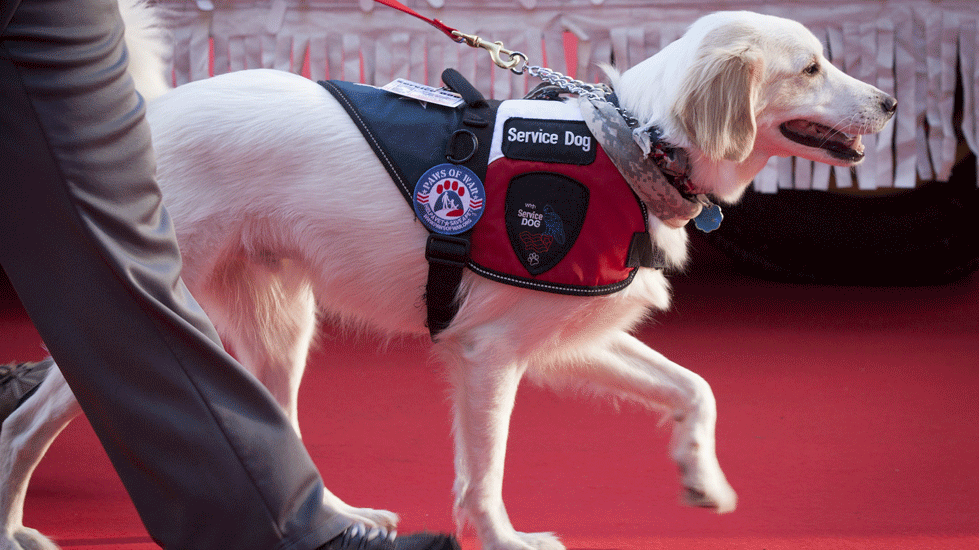Strolling with a happy, tail-wagging companion securely by our sides is one of life’s greatest joys. We love our furry, four-legged friends. While dogs are America’s most beloved pet, humans have bred and domesticated dogs for thousands of years for important work functions. Modern day working dog are employed in tasks ranging from drug and explosive detection, agriculture, tracking, emergency recovery, mental health treatment, and much more. Service dogs are working partners for people with disabilities. Hearing dogs are specifically trained to support the needs of severely hearing impaired people. They serve as their masters’ ears and provide the added benefit of companionship. By federal law, service animals including hearing dogs may go anywhere the public is permitted (restaurants, stores, government buildings, etc.) and live in housing where pets are prohibited. They are not pets–but valuable assistants for people with disabilities.
Hearing dogs are trained to alert their owners to common sounds like doorbells, oven timers, smoke alarms, telephones, babies’ cries, or alarm clocks. Hearing dogs make physical contact with their masters, nudging or pawing them to get their attention. Most are trained to lead their handlers toward the source of a sound.
Outside the home, hearing dogs perform additional duties. Most will not respond to ambient street noises like car horns or sirens. However, because they are keenly alert to environmental sounds, their partners can ascertain a great deal of information about their surroundings by observing the dogs’ cues. This serves to alert people with severe hearing losses to the approach of persons or vehicles which may be a threat or hazard. Owners of hearing dogs report that having a trained canine helper gives them an increased sense of security and independence that other assistive means just can’t provide.
What types of canine make the best hearing dogs?
Although hearing dogs must be trained for their specific duties, there are natural traits that make some dogs better candidates than others. Characteristics of a model hearing dog are as follows:
- Naturally attentive to sound
- Alert and ready to work in an instant
- Friendly and people-oriented
- Steady temperament, calm in crowds
- Focused on its task
- Confident but not dominant
Most hearing dogs are small to medium mixed breed animals. Many are rescued from shelters; others come from professional breeders. While hearing dogs come in all kennel classes and varieties, certain purebreds are also well-suited to the role. These include Labrador Retrievers, Golden Retrievers, Poodles and Cocker Spaniels. Because hearing dogs are best active and alert, many are a terrier mix. Pedigree is, however, far less important than trainability and a temperament ideally suited to the work.
Training a hearing dog
While temperament and instinct are prominent features of successful hearing dogs, they must be expertly trained for their specific duties. The dogs are trained to perform both on and off a lead and to work for small rewards and affection. Instruction starts with basic socialization and obedience training: stay, sit, come, heel.
Next, the dogs receive several months of audio-response training. They are taught to respond to specific sounds in the home such as smoke alarms, telephones, doorbells, or a knock at the door. Once a deaf or hard of hearing person is carefully matched with his or her hearing dog, the two are trained to work together as a team. The dog may then be trained for other specific sounds, like a teakettle whistle, specific household appliances or alerts in their master’s home environment, and someone calling the master’s name.
Numerous organizations across the country train and provide hearing dogs for members of the deaf community and other hearing impaired candidates. Assistance Dogs International is an excellent source for locating a hearing dog provider near you.
Hearing dog training and placement organizations will typically utilize a preliminary screening process followed by an in-depth application and interview. Finding a good match and completing the training process may take a few weeks to several months.
It’s important to know that training a hearing dog is an expensive proposition which can run $20,000 or more. The cost to clients varies across organizations, but most require an application fee. Some collect a deposit which is returned to the owner after a specified time. Other organizations offer hearing dogs at no cost to clients and raise the extensive funds needed through donations. Still others will require clients to share in the cost, encouraging them to conduct community fundraisers to defray at least a portion of expenses. The new owner also assumes the total financial responsibility for the animal’s care.
According to Micheleigh Perez, Staff Audiologist with Hearing Planet, a hearing dog cannot replace the use of properly fit hearing devices for people with significant hearing loss. Hearing dogs add to their masters’ sense of security and support. Some people with hearing loss may also feel a certain amount of isolation especially when home alone. A hearing dog is not only a working partner, but a wonderful companion and source of emotional connection as well.


